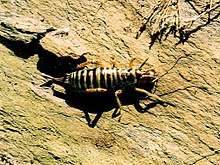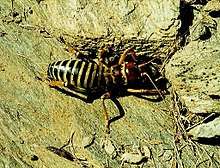Hemideina maori
| Hemideina maori | |
|---|---|
 | |
| Female | |
 | |
| Male | |
| Scientific classification | |
| Kingdom: | Animalia |
| Phylum: | Arthropoda |
| Class: | Insecta |
| Order: | Orthoptera |
| Suborder: | Ensifera |
| Family: | Anostostomatidae |
| Genus: | Hemideina |
| Species: | H. maori |
| Binomial name | |
| Hemideina maori | |
Hemideina maori, also known as the mountain stone wētā, is a weta of the family Anostostomatidae.
Physiology
Mountain stone wētā can survive being frozen for months in a state of suspended animation down to temperatures of about -10 °C. At temperatures below -10 °C, approximately 85% of their body water is crystallised, one of the highest ice contents known for any animal.[1][2] During winter, their haemolymph contains low molecular weight cryoprotectants such as amino acids, especially proline (up to about 100 mM) and the disaccharide trehalose. These substances are synthesised during autumn and their concentration decreases again during spring and summer (proline concentration decreases to about 10 mM during summer). The amino acids and sugars presumably help to decrease the ice content colligatively; however, they probably also have a direct protective effect on membranes and proteins via direct interaction or by modifying the water layer with the closest proximity to the molecules.
Behaviour
To defend against predators, mountain stone wētā will often "play dead", by lying still for a short time on their back, with legs splayed and claws exposed and jaws wide open ready to scratch and bite. This behaviour is often accompanied with regurgitation.
References
- ↑ Wharton, D. A (1997). "Avoidance of intracellular freezing by the freezing-tolerant New Zealand Alpine weta Hemideina maori (Orthoptera: Stenopelmatidae)". J Insect Physiol. PMID 12769972.
- ↑ Toki, Nicola (2012-08-31). "Cryogenic creepy crawlies". Stuff.co.nz. Retrieved 25 February 2017.